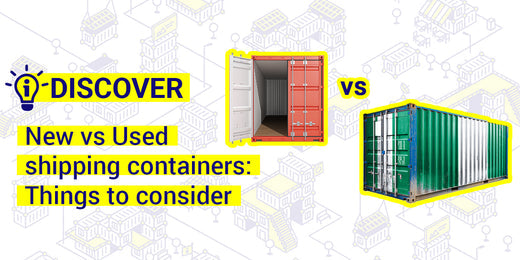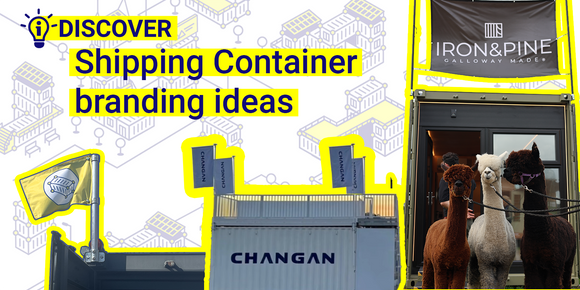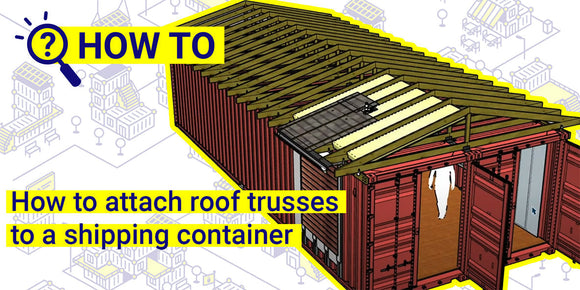
New vs Used shipping containers: Things to consider
In this blog we look at the things to consider when deciding whether to use a new or used shipping container for your container project.
When buying or renting a shipping container, the most important questions you should be asking yourself are;
- What will I be using the container for?
- What’s my budget?
- Do I need to make alterations to the container?
Let’s look at each of these considerations and see how they might affect your choice of buying a new or an old container.
First off, do you even need to buy the container?
If you need a container kitted out for a particular job, such as a food stand, shop or office and if your budget is not a major consideration then there are lots of companies that sell or lease containers that have already been converted for a specific purpose, this would of course be the easiest option.
When leasing a container, you might think that making alterations to it would be out of the question but using Domino Clamps to attach lighting, CCTV, an awning or perhaps a carport means that they can easily be bolted on and safely removed without any damage to the container once it needs to be returned.
However, not everyone has the budget to rent a professionally converted container, or you may plan to keep using it for many years to come. If this is the case, you're best off being the owner and doing the conversion yourself, so a little surface rust that needs fixing on a second hand container on top of the rest of your renovation plans is probably not a big deal.
What will I be using the container for?
Shipping containers are incredibly versatile, and there’s number of differences between new and used shipping containers that will affect your choice, depending on what you plan to use the container for.
Seaworthiness
The most obvious application that will help make this decision for you is whether the container needs to go back out to sea. New ISO containers should be legally worthy and certificated to go back out to carry goods for export, whereas a used container may need recertification for this purpose. Using Domino Clamps will not affect the seaworthiness of a new container, so you can use them on a shipping container without ever risking causing damage which would render its certification invalid.
Durability
A new container can be expected to last 2-3 times longer than a used one, with fewer dents and scratches meaning that it stands up to the elements better, especially if used for a long period outside. This exposure can be mitigated on a static used shipping container by using Domino Clamps to attach a roof or cover over the top to prevent standing water from gathering on the roof.
Used containers are usually for sale in graded conditions and would normally come with a guarantee to be at least water tight for a given period of time. How long one of these lasts will depend entirely on its condition, as well as how and where you keep it. Regardless of the state of your container, it is unlikely you will come across a second hand container for sale in such poor condition that its structure is compromised to such an extent that it won’t accept our Domino Clamps in its corner castings, or be able to have any of our numerous shipping container accessory kits attached to it.
Aesthetics
New containers will not only be in great condition, as they would not have suffered the wear and tear of multiple trips at sea but will generally come in one solid colour without logos or markings from the transportation companies, so if the appearance of the container is a priority this could be your best option.
Second hand containers that have been part of a large rental fleet are likely to come with more dents, scuffs and some surface rust but there are various options to make your used container more aesthetically pleasing; the container can be painted once the rust has been removed, you could consider covering your container with timber cladding, a camo net or a drape, or a banner.
Security
New containers often come with a factory fitted lock box which would be beneficial if you are planning on using your container for storage, although these can generally be fitted to a used container at extra cost before purchase if required.
Long Term safety
Used shipping containers will have been used to transport all sorts of things including unpleasant or even toxic substances which may leech or spill during their journey. You may want to consider a new container without such nastiness if the container is likely to have people or animals in it for long periods of time.
What’s my budget?
Even though a new shipping container is not technically new (they will all have made at least one trip from their country of manufacture - usually China), a new container can cost up to twice as much as a used container depending on its size and current market demands.
Prices for containers have almost doubled in the past year due to the knock on effect of the Coronavirus pandemic, leading to a shortage of new containers and an increase in price. This has also led to a shortage of used containers as shipping lines hold on to their containers and continue to use them rather than sell them off, so if budget is a major factor in your decision, a used container might well be a better option.
Making alterations
Since new containers are significantly more expensive than used ones, you’ll be even less likely to want to do anything to your new container to damage it. Usually this would rule out a lot of alterations which require drilling into the container or welding things to it, but with Domino Camps you can add any number of attachments from lighting to signage and steel tube without damaging your recent purchase.
However Domino Clamps can only help you attach to the corner casting of the container, so if your alterations plans require attachments elsewhere, you want to be doing this to a cheaper, older container, rather than massively devaluing a new one.
Think carefully before carrying our modifications to any container. You will be devaluing your asset as well as potentially compromising its structure, weatherproofing, and ability to go back out to sea. Shipping containers in good condition hold their value well, so if you plan to sell it on at a later date, the less you can do to damage the container, the better.
For more ingenious container solutions, useful information and offers delivered direct to your inbox, sign up to our information email 📨 or subscribe to our YouTube channel 📺







